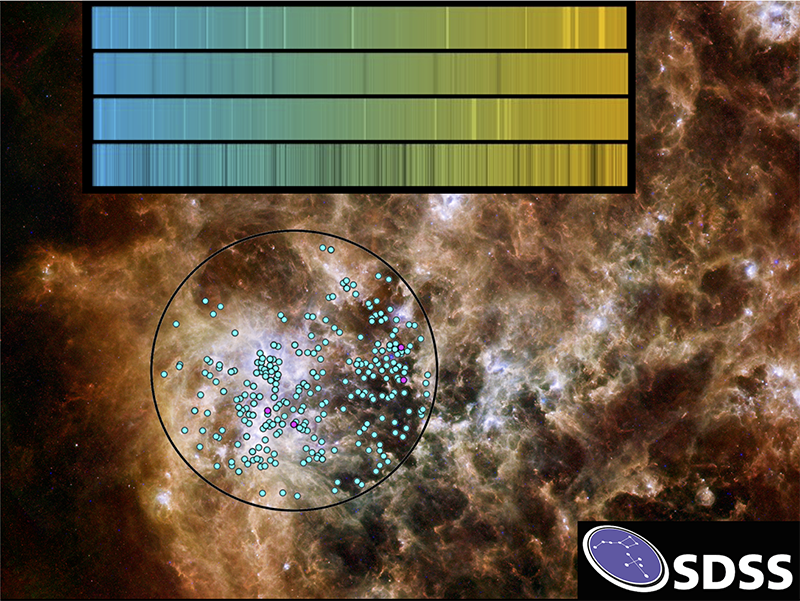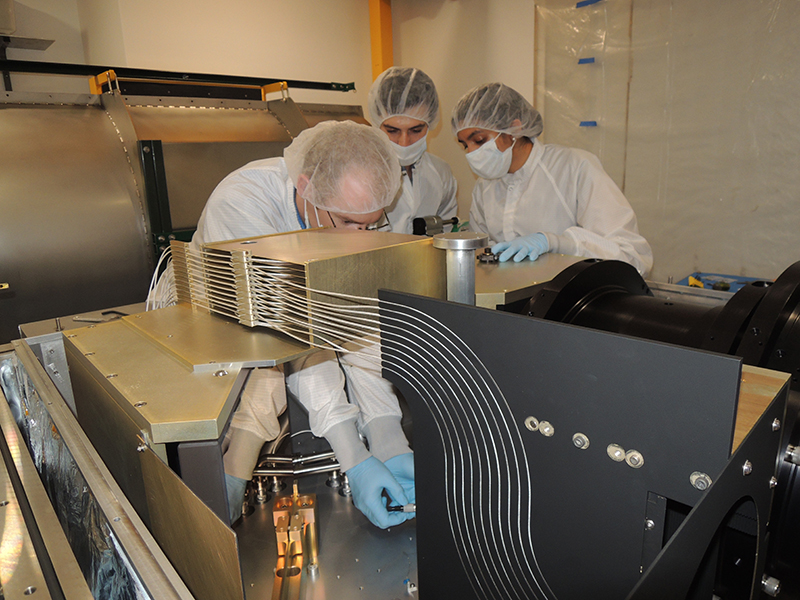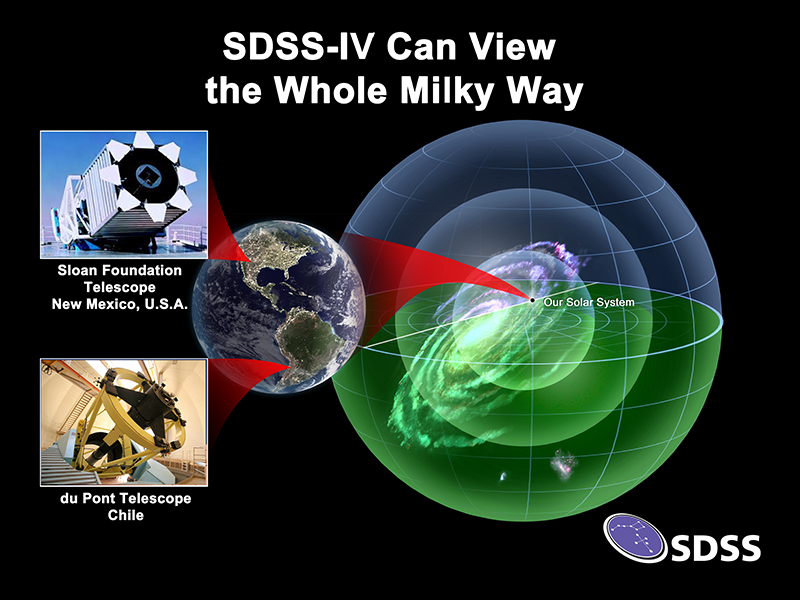
The first light observations included spectra of supermassive stars in the Tarantula Nebula. This nebula in the Large Magellanic Cloud is forming stars more rapidly than any other region in our Local Group of galaxies. It can only be seen from the Southern Hemisphere, underscoring the importance of APOGEE South’s location. The spectrograph will allow us to study the chemistry and evolution of the stars in the nebula in greater detail than ever before.
Image Credit: SDSS collaboration; Tarantula Nebula image from Herschel/Spitzer
Earlier this month, the Sloan Digital Sky Survey (SDSS) reached an important milestone by opening its “second eye on the sky” – a new instrument called the “APOGEE South spectrograph.”
This new instrument at Las Campanas Observatory in Chile is the twin of the APOGEE North spectrograph, and will let astronomers study stars across the whole Milky Way like never before.
The name APOGEE is short for the Apache Point Observatory Galaxy Evolution Experiment, based on the location of the experiment’s first “eye” at Apache Point Observatory, New Mexico. “The original APOGEE made history by measuring extremely detailed properties of more stars than ever before,” said Steven Majewski of the University of Virginia, Principal Investigator of the APOGEE experiment. “But we always wanted a more complete view, especially because the center of the Galaxy is best seen from the Southern Hemisphere. With the APOGEE South spectrograph, we are finally realizing that vision.” Data collected by the twin instruments will help astronomers make a map of the entire Milky Way, with an unprecedented combination of size and detail.
Steven Majewski
“We always wanted a more complete view, especially because the center of the Galaxy is best seen from the Southern Hemisphere.”
The APOGEE South spectrograph in Chile is identical to the original APOGEE spectrograph in New Mexico. Both work by spreading starlight into detailed rainbow patterns called “spectra.” Astronomers use these spectra to determine the chemical compositions of those stars, and also to find subtle shifts due to the Doppler Effect created by the stars’ motion through space. These pieces of information – composition and velocity – are combined with the known stellar positions to create an incredibly detailed map of our Galaxy.

Image Credit: John Wilson (University of Virginia)
John Wilson of the University of Virginia, APOGEE’s Instrument Scientist, explains the decision to build identical instruments in two hemispheres: “If the two spectrographs are exactly the same, then the spectra we collect from them will also be the same. We don’t need to worry that differences we see are due to differences in instrument design. We can directly compare the parts of our Galaxy we can see from the Northern and Southern Hemispheres.”
The APOGEE experiment to date has measured more than one million spectra of 277,000 individual stars, making it the largest high-resolution, near-infrared spectroscopic sample of stars ever observed. By working in infrared light, the APOGEE instruments can peer through the thick clouds of dust that obscure the inner Milky Way. By the end of APOGEE South’s mission, the number of stars observed will double, resulting in the most complete map of the Milky Way ever created.

Image Credit: Dana Berry/SkyWorks Digital Inc.; SDSS collaboration
The new APOGEE South spectrograph is located at the Irénée du Pont Telescope at Las Campanas Observatory, located at an elevation of 2,400 meters (8,000 feet) in the Atacama Desert of Northern Chile — about the same distance south of the equator as the New Mexico site of the original APOGEE spectrograph is to the north.
“Looking from the Southern Hemisphere will allow us to study the innermost regions of our Galaxy,” said Manuela Zoccali of Pontifica Universidad Católica de Chile and the Millennium Institute of Astrophysics, the chair of the SDSS Chilean Participation Group. “This is the first time that a large team of Chileans has worked with colleagues around the world on such an ambitious project. We are pleased we can now work together on the first data.”
The director of the SDSS-IV project, Michael Blanton of New York University, agrees. “Working with our colleagues in Chile has helped us extend our survey in exciting new ways. Ever since we began in 2000, people have asked us when we would go to the Southern Hemisphere. We are delighted to have found a second home at Las Campanas.”
Images

The first light observations included spectra of supermassive stars in the Tarantula Nebula. This nebula in the Large Magellanic Cloud is forming stars more rapidly than any other region in our Local Group of galaxies. It can only be seen from the Southern Hemisphere, underscoring the importance of APOGEE South’s location. The spectrograph will allow us to study the chemistry and evolution of the stars in the nebula in greater detail than ever before.
Image Credit: SDSS collaboration; Tarantula Nebula image from Herschel/Spitzer

Image Credit: John Wilson (University of Virginia)

Image Credit: Dana Berry/SkyWorks Digital Inc.; SDSS collaboration
About the Sloan Digital Sky Survey
Funding for the Sloan Digital Sky Survey IV has been provided by the Alfred P. Sloan Foundation, the U.S. Department of Energy Office of Science, and the Participating Institutions. SDSS acknowledges support and resources from the Center for High-Performance Computing at the University of Utah. The SDSS web site is www.sdss.org.
SDSS is managed by the Astrophysical Research Consortium for the Participating Institutions of the SDSS Collaboration including the Brazilian Participation Group, the Carnegie Institution for Science, Carnegie Mellon University, the Chilean Participation Group, the French Participation Group, Harvard-Smithsonian Center for Astrophysics, Instituto de Astrofísica de Canarias, The Johns Hopkins University, Kavli Institute for the Physics and Mathematics of the Universe (IPMU) / University of Tokyo, Lawrence Berkeley National Laboratory, Leibniz Institut für Astrophysik Potsdam (AIP), Max-Planck-Institut für Astronomie (MPIA Heidelberg), Max-Planck-Institut für Astrophysik (MPA Garching), Max-Planck-Institut für Extraterrestrische Physik (MPE), National Astronomical Observatories of China, New Mexico State University, New York University, University of Notre Dame, Observatório Nacional / MCTI, The Ohio State University, Pennsylvania State University, Shanghai Astronomical Observatory, United Kingdom Participation Group, Universidad Nacional Autónoma de México, University of Arizona, University of Colorado Boulder, University of Oxford, University of Portsmouth, University of Utah, University of Virginia, University of Washington, University of Wisconsin, Vanderbilt University, and Yale University.
About the Chilean Participation Group of SDSS-IV
The infrastructure for the APOGEE South instrument has been developed and will be operated in a partnership with seven universities in Chile: Pontificia Universidad Católica, Universidad Andres Bello, Universidad de Antofagasta, Universidad de Chile, Universidad de Concepción, Universidad de La Serena, and Universidad de Valparaíso.
Quelle: Astrophysical Research Consortium (ARC) and The Sloan Digital Sky Survey (SDSS)
